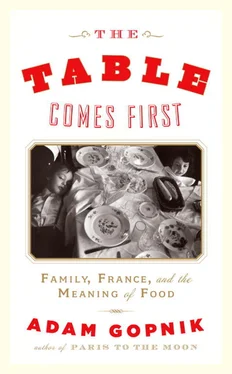At the ideal Habermasian table, it seems, everyone would argue about what to have, and there would be a vote on it, and everyone would emerge a better citizen. (I have eaten with Germans like that.) The political scientist Robert Putnam has become famous in America for making a similar point: social capital is made up of bowling leagues and glee clubs and 4-H groups, and what’s lost when these groups are lost can’t be made up by the semiprivate realm of fast-food joints or video arcades.
Surely a wiser point, though—one neither too German in its earnestness nor too unreal in its gloom—is that we build as much social capital, civic good, from semiprivate places as we do from public ones. There are many collegial institutions—the bowling league, the gardening club, the scout troop, the block party—that are obviously virtuous, and then there are some, like the restaurant, that may not be quite so wholesome but are benevolent all the same, in that they extend the blessings of freedom to letting you order what you choose. After all, the other exemplary nineteenth-century public place where you could go whenever you liked but couldn’t talk to the person beside you was a library. Our sense of liberty begins not with the freedom to argue but with the freedom not to have to argue—to do what we like, whenever we like to do it, without having to make an articulate case one way or another. This is why teenagers, despite their privileges, feel so un-free. They are stuck in Habermasian society, always obliged to make the case for their pleasures.
Loneliness is not the “price” of liberty but part of the profit we take from it. The restaurant’s moral glory, like that of the library and the department store—another nineteenth-century bourgeois invention—is its semiprivate state, for semi-ness is the special half-tint of bourgeois societies. The bowling league has been replaced not by solitary bowling but, more decisively, by the gym, another classic semiprivate place: on the bike you read your newspaper as you pedal in a long row of solitudes.
In the same way, at the restaurant on Third Avenue now as at the Palais Royal then, our joys intersect with those of others only at odd angles. My tenth birthday, though it passed so gloriously in the Howard Johnson’s, passed unmarked by anyone but my three friends, my parents, and me and left only a memory. My first lunch in the Palais Royal was another lunch service among ten thousand at the Grand Véfour, and no one else who was there will think of it again at all.
That is not our sadness, except in the sense that all that passes makes us sad. It is also part of what makes a thing good. Happiness may come at us face-to-face, but joy always comes at us at an angle. We are used to the arrival; for a man it’s when your wife, the perfect girl, comes back from powdering her nose, and you first catch sight of her out of the corner of your eye. The pleasures of the restaurant are occluded, sudden, haphazard in this way. You’re eating at this table, and you listen to that one. You’re watching one woman, or man, and spy from the corner of your eye another. The taste of your dinner mingles, or used to, with the aroma of your neighbor’s cigar. Places of hope, restaurants and cafés are also places of reassuring mystery, and the mystery reassures because, in reminding us of lives and appetites beyond our own, they remind us of worlds we have yet to enter.
As with most interesting inventions of bourgeois culture, restaurant-going is cushioned on the surface, angular and dramatic just beneath. It is a study in tensions and role-playing. To visit Le Grand Véfour, the one restaurant that remains intact and has been in business continuously since Roze de Chantoiseau’s day, is to instantly take part in a drama that has gone on so long because its point is so unsettled. The maître d’ is both servant, having to wait, and master, being empowered to choose and offer. The customer is both aristocrat for an hour and anxious suitor. Even the closed kitchen, while it distances the work, increases the mystique. If the dimwitted diner doesn’t know what goes on back there, it is still the case that the ultimate compliment to the savvy diner is to be invited into the kitchen. We eat out to find out who we are, and part of who we are is who we pretend to be, and whom we elect to pay for our pretense.
The roles we play are part of the people we are. All democratic society may or may not begin in small communities, but all civility depends on little lies. The restaurant is our classroom for what Dr. Johnson called “fictitious benevolence,” and teaches its first lesson: as important as finding people you have things in common with is learning to live in pleasure alongside people with whom you don’t. This may be why, though there’s a new “new cooking” every few years, the institution of the restaurant has shown itself so resilient, so durable, so amazingly the same across time and tears. The waiter now introduces himself by name, and he may have changed his tux for an Agnès B. collarless shirt, but he still comes and goes and rarely mentions money. We might gag on what was served at Chantoiseau’s restaurant, we might not be able to find our idea of a good meal at Véry’s little temple, but, seeing the pantomime of waiters and menus and mirrors and erotic murmur, we would know at once just where we were. Home, Robert Frost wrote, is the place where, when you have to go there, they have to take you in. A restaurant is a place where, when you go there, they not only have to take you in but have to act as though they were glad to see you. In cities of strangers, this pretense can be very dear.
A MAN AND A WOMAN lie in bed at night in the short hour between kid sleep and parent sleep, turning down page corners as they read. She is leafing through a fashion magazine, he through a cookbook. Why they read these things mystifies even the readers. The closet and the cupboard are both about as full as they’re going to get, and though we can credit the magazine reader with at least wanting to know what is in fashion when she sees it, what can the recipe reader possibly be reading for? The shelf of cookbooks long ago overflowed, so that the sad relations and failed hopes ( Monet’s Table , A Drizzle of Honey: The Lives and Recipes of Spain’s Secret Jews ) now are stacked horizontally, high up. The things he knows how to make that are actually in demand are as fixed as any cocktail-lounge pianist’s set list, and for a clientele of children every bit as devoted to the old favorites as the barflies around that piano: make Parmesan-crusted chicken—the “Feelings” of food—every night and they would be delighted. Though a dinner party looms, and with it the possibility of a new thing made and added to the repertoire, the truth is that, on the night, the amateur cook falls back, like the amateur actor, on the set recitation. It’s going to be lamb tagine or the roasted chicken thing with preserved lemons, and there’s no helping it…. Yet the new cookbooks continue to show up in bed, and the corners still go down.
Vicarious pleasure? More like deferred frustration. Anyone who cooks knows that it is in following recipes that one first learns about the anticlimax of the actual, the perpetual disappointment of the thing achieved. I learned it as I learned to bake. When I was in my early teens, the sick yearning for sweets that adolescents suffer often drove me, in afternoons taken off from school, to bake, which, miraculously, meant just doing what the books said and hoping to get the promised yield. I followed the recipes as closely as I could: dense Boston cream pie, Rigó Jansci slices, Sacher torte with apricot jam between the layers. The potential miracle of the cookbook was immediately apparent: you start with a feeling of greed, find a list of rules, assemble a bunch of ingredients, and then you have something to be greedy about. In cooking you begin with the ache and end with the object, where in most of the life of the appetites—courtship, marriage—you start with the object and end with the ache.
Читать дальше












